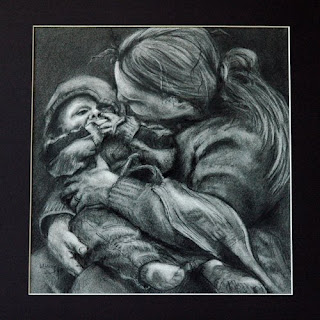"A Mother's Love" or "A Precious Moment"
(titles are difficult for me!)
charcoal drawing on Rives BFK, image is ~15 x 15 inch, matted size is 18 x18 inch
copyright MaryAnn Cleary
charcoal drawing on Rives BFK, image is ~15 x 15 inch, matted size is 18 x18 inch
copyright MaryAnn Cleary
Well, this is the final version of a drawing that was posted on my other blog a couple of days ago. I tend to fuss with drawings until I feel that I have all the bugs worked out...especially in charcoal. I did leave it sit for a couple of days and I did send it off to my sweet daughter as she could look at it with fresh eyes. She also is not fearful of saying how it is...so off with the claw hand and there was an area that bothered us both...so fixed.
When doing a drawing like this I really like to put it on an easel, but this one I had on my drawing table. It is difficult to stand back and take a look without standing on a chair and trying not to fall. Eventually, I did pull it off the table and mount it to a board so that I could see it and finish it on an easel. What a difference!!!
If anyone would like a drawing similar of a loved one in their life, let me know. Of course there usually is money involved in doing something like this. I like to take photos, do sketches in real life, do a preliminary drawing and then work on the final piece. It takes considerable time, but the end results is usually worth it.
Enjoy!









